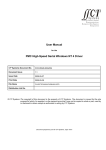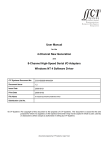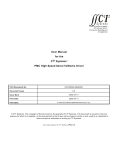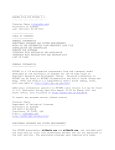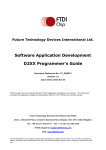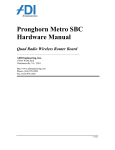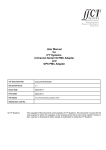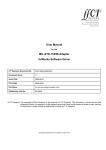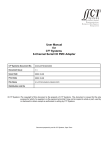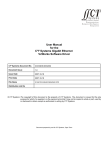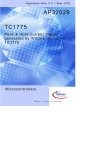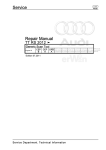Download User Manual High-Speed Serial I/O Adapter Windows NT 4 Software
Transcript
CCII Systems (Pty) Ltd Registration No. 1990/005058/07
C ommunications
C omputer I ntellig ence
I nteg ration
User Manual
for the
High-Speed Serial I/O Adapter
Windows NT 4 Software Driver
C²I² Systems Document No.
CCII/HSS/6-MAN/004
Document Issue
1.2
Issue Date
2009-09-03
Print Date
2009-09-04
File Name
P:\HSS\TECH\MAN\CHSMAN04.WPD
Distribution List No.
© C²I² Systems The copyright of this document is the property of C²I² Systems. The document is issued for the sole
purpose for which it is supplied, on the express terms that it may not be copied in whole or part, used by
or disclosed to others except as authorised in writing by C²I² Systems.
Document prepared by C²I² Systems, Cape Town
Signature Sheet
Name
Signature
Date
Completed by
Project Engineer
Board Level Products
C²I² Systems
Accepted by
Project Manager
Board Level Products
C²I² Systems
Accepted by
Quality Assurance
C²I² Systems
CCII/HSS/6-MAN/004
CHSMAN04.WPD
2009-09-03
Issue 1.2
Page ii of vii
Amendment History
Issue
Description
Date
ECP No.
1.0
Initial version.
2003-07-18
-
1.1
Changed title.
2009-05-27
CCII/BLPGEN/6-ECP/015
1.2
Improve document naming consistency.
2009-09-03
CCII/HSS/6-ECP/018
CCII/HSS/6-MAN/004
CHSMAN04.WPD
2009-09-03
Issue 1.2
Page iii of vii
Contents
1.
Scope . . . . . . . . . . . . . . . . . . . . . . . . . . . . . . . . . . . . . . . . . . . . . . . . . . . . . . . . . . . . . . . . . . . 1
1.1
1.2
2.
Applicable and Reference Documents . . . . . . . . . . . . . . . . . . . . . . . . . . . . . . . . . . . . . . . . . 2
2.1
2.2
3.
4.4
5.5
5.6
5.7
Protocol Selection . . . . . . . . . . . . . . . . . . . . . . . . . . . . . . . . . . . . . . . . . . . . . . . . . . . . . . . . . . . . . . . . . . . . 7
Using the Control Panel to Change Port Settings . . . . . . . . . . . . . . . . . . . . . . . . . . . . . . . . . . . . . . . . . . . . 8
Using the Control Panel to Obtain the Current Version Information . . . . . . . . . . . . . . . . . . . . . . . . . . . . . . 8
UART Mode . . . . . . . . . . . . . . . . . . . . . . . . . . . . . . . . . . . . . . . . . . . . . . . . . . . . . . . . . . . . . . . . . . . . . . . . . 9
5.4.1 UART Protocol Information . . . . . . . . . . . . . . . . . . . . . . . . . . . . . . . . . . . . . . . . . . . . . . . . . . . . . . 10
HDLC Mode . . . . . . . . . . . . . . . . . . . . . . . . . . . . . . . . . . . . . . . . . . . . . . . . . . . . . . . . . . . . . . . . . . . . . . . . 12
5.5.1 HDLC Protocol Information Members . . . . . . . . . . . . . . . . . . . . . . . . . . . . . . . . . . . . . . . . . . . . . . 13
5.5.2 Preamble Requirements . . . . . . . . . . . . . . . . . . . . . . . . . . . . . . . . . . . . . . . . . . . . . . . . . . . . . . . . 15
BISYNC Mode . . . . . . . . . . . . . . . . . . . . . . . . . . . . . . . . . . . . . . . . . . . . . . . . . . . . . . . . . . . . . . . . . . . . . . 16
5.6.1 BISYNC Protocol Information Members . . . . . . . . . . . . . . . . . . . . . . . . . . . . . . . . . . . . . . . . . . . . 17
SMC UART Mode . . . . . . . . . . . . . . . . . . . . . . . . . . . . . . . . . . . . . . . . . . . . . . . . . . . . . . . . . . . . . . . . . . . 20
5.7.1 SMC UART Protocol Information Members . . . . . . . . . . . . . . . . . . . . . . . . . . . . . . . . . . . . . . . . . 20
Getting Started . . . . . . . . . . . . . . . . . . . . . . . . . . . . . . . . . . . . . . . . . . . . . . . . . . . . . . . . . . . 22
6.1
6.2
7.
Windows SDK Serial Functions . . . . . . . . . . . . . . . . . . . . . . . . . . . . . . . . . . . . . . . . . . . . . . . . . . . . . . . . . . 5
Windows SDK Serial Structures . . . . . . . . . . . . . . . . . . . . . . . . . . . . . . . . . . . . . . . . . . . . . . . . . . . . . . . . . 5
Function Limitations . . . . . . . . . . . . . . . . . . . . . . . . . . . . . . . . . . . . . . . . . . . . . . . . . . . . . . . . . . . . . . . . . . . 5
4.3.1 ClearCommError . . . . . . . . . . . . . . . . . . . . . . . . . . . . . . . . . . . . . . . . . . . . . . . . . . . . . . . . . . . . . . 5
4.3.2 GetCommMask . . . . . . . . . . . . . . . . . . . . . . . . . . . . . . . . . . . . . . . . . . . . . . . . . . . . . . . . . . . . . . . . 5
4.3.3 SetCommMask . . . . . . . . . . . . . . . . . . . . . . . . . . . . . . . . . . . . . . . . . . . . . . . . . . . . . . . . . . . . . . . . 5
4.3.4 WaitCommEvent . . . . . . . . . . . . . . . . . . . . . . . . . . . . . . . . . . . . . . . . . . . . . . . . . . . . . . . . . . . . . . . 6
4.3.5 Overlapped Writes . . . . . . . . . . . . . . . . . . . . . . . . . . . . . . . . . . . . . . . . . . . . . . . . . . . . . . . . . . . . . 6
4.3.6 FlushFileBuffers . . . . . . . . . . . . . . . . . . . . . . . . . . . . . . . . . . . . . . . . . . . . . . . . . . . . . . . . . . . . . . . 6
Structure Limitations . . . . . . . . . . . . . . . . . . . . . . . . . . . . . . . . . . . . . . . . . . . . . . . . . . . . . . . . . . . . . . . . . . 6
4.4.1 COMMCONFIG . . . . . . . . . . . . . . . . . . . . . . . . . . . . . . . . . . . . . . . . . . . . . . . . . . . . . . . . . . . . . . . 6
4.4.2 COMMPROP . . . . . . . . . . . . . . . . . . . . . . . . . . . . . . . . . . . . . . . . . . . . . . . . . . . . . . . . . . . . . . . . . 6
4.4.3 COMMTIMEOUTS . . . . . . . . . . . . . . . . . . . . . . . . . . . . . . . . . . . . . . . . . . . . . . . . . . . . . . . . . . . . . 6
4.4.4 COMSTAT . . . . . . . . . . . . . . . . . . . . . . . . . . . . . . . . . . . . . . . . . . . . . . . . . . . . . . . . . . . . . . . . . . . 6
4.4.5 DCB . . . . . . . . . . . . . . . . . . . . . . . . . . . . . . . . . . . . . . . . . . . . . . . . . . . . . . . . . . . . . . . . . . . . . . . . 6
Driver Protocol Settings . . . . . . . . . . . . . . . . . . . . . . . . . . . . . . . . . . . . . . . . . . . . . . . . . . . . 7
5.1
5.2
5.3
5.4
6.
Installing The HSS Windows NT 4 Software Driver Files . . . . . . . . . . . . . . . . . . . . . . . . . . . . . . . . . . . . . . 3
Uninstalling The HSS Windows NT 4 Software Driver . . . . . . . . . . . . . . . . . . . . . . . . . . . . . . . . . . . . . . . . 3
Updating the Device Firmware . . . . . . . . . . . . . . . . . . . . . . . . . . . . . . . . . . . . . . . . . . . . . . . . . . . . . . . . . . . 3
Using the Event Viewer . . . . . . . . . . . . . . . . . . . . . . . . . . . . . . . . . . . . . . . . . . . . . . . . . . . . . . . . . . . . . . . . 4
Application Program Interface . . . . . . . . . . . . . . . . . . . . . . . . . . . . . . . . . . . . . . . . . . . . . . . 5
4.1
4.2
4.3
5.
Applicable Documents . . . . . . . . . . . . . . . . . . . . . . . . . . . . . . . . . . . . . . . . . . . . . . . . . . . . . . . . . . . . . . . . . 2
Reference Documents . . . . . . . . . . . . . . . . . . . . . . . . . . . . . . . . . . . . . . . . . . . . . . . . . . . . . . . . . . . . . . . . . 2
Configuration Procedure . . . . . . . . . . . . . . . . . . . . . . . . . . . . . . . . . . . . . . . . . . . . . . . . . . . . 3
3.1
3.2
3.3
3.4
4.
Identification . . . . . . . . . . . . . . . . . . . . . . . . . . . . . . . . . . . . . . . . . . . . . . . . . . . . . . . . . . . . . . . . . . . . . . . . . 1
Introduction . . . . . . . . . . . . . . . . . . . . . . . . . . . . . . . . . . . . . . . . . . . . . . . . . . . . . . . . . . . . . . . . . . . . . . . . . 1
Normal Write Operation . . . . . . . . . . . . . . . . . . . . . . . . . . . . . . . . . . . . . . . . . . . . . . . . . . . . . . . . . . . . . . . 22
Overlapped Read Operation . . . . . . . . . . . . . . . . . . . . . . . . . . . . . . . . . . . . . . . . . . . . . . . . . . . . . . . . . . . 22
Contact Details . . . . . . . . . . . . . . . . . . . . . . . . . . . . . . . . . . . . . . . . . . . . . . . . . . . . . . . . . . . 23
7.1
7.2
Contact Person . . . . . . . . . . . . . . . . . . . . . . . . . . . . . . . . . . . . . . . . . . . . . . . . . . . . . . . . . . . . . . . . . . . . . 23
Physical Address . . . . . . . . . . . . . . . . . . . . . . . . . . . . . . . . . . . . . . . . . . . . . . . . . . . . . . . . . . . . . . . . . . . . 23
CCII/HSS/6-MAN/004
CHSMAN04.WPD
2009-09-03
Issue 1.2
Page iv of vii
7.3
7.4
7.5
Postal Address . . . . . . . . . . . . . . . . . . . . . . . . . . . . . . . . . . . . . . . . . . . . . . . . . . . . . . . . . . . . . . . . . . . . . . 23
Voice and Electronic Contacts . . . . . . . . . . . . . . . . . . . . . . . . . . . . . . . . . . . . . . . . . . . . . . . . . . . . . . . . . . 23
Product Support . . . . . . . . . . . . . . . . . . . . . . . . . . . . . . . . . . . . . . . . . . . . . . . . . . . . . . . . . . . . . . . . . . . . . 23
CCII/HSS/6-MAN/004
CHSMAN04.WPD
2009-09-03
Issue 1.2
Page v of vii
List of Illustrations
Figure 1 : Installation Wizard . . . . . . . . . . . . . . . . . . . . . . . . . . . . . . . . . . . . . . . . . . . . . . . . . . . . . . . . . . . . . . . . . . 3
Figure 2 : Applet Icon . . . . . . . . . . . . . . . . . . . . . . . . . . . . . . . . . . . . . . . . . . . . . . . . . . . . . . . . . . . . . . . . . . . . . . . . 7
Figure 3 : Driver Information Dialogue . . . . . . . . . . . . . . . . . . . . . . . . . . . . . . . . . . . . . . . . . . . . . . . . . . . . . . . . . . . 8
Figure 4 : UART Dialogue . . . . . . . . . . . . . . . . . . . . . . . . . . . . . . . . . . . . . . . . . . . . . . . . . . . . . . . . . . . . . . . . . . . . 9
Figure 5 : UART Advanced Dialogue . . . . . . . . . . . . . . . . . . . . . . . . . . . . . . . . . . . . . . . . . . . . . . . . . . . . . . . . . . . . 9
Figure 6 : HDLC Dialogue . . . . . . . . . . . . . . . . . . . . . . . . . . . . . . . . . . . . . . . . . . . . . . . . . . . . . . . . . . . . . . . . . . . 12
Figure 7 : HDLC Advanced Dialogue . . . . . . . . . . . . . . . . . . . . . . . . . . . . . . . . . . . . . . . . . . . . . . . . . . . . . . . . . . . 12
Figure 8 : BISYNC Dialogue . . . . . . . . . . . . . . . . . . . . . . . . . . . . . . . . . . . . . . . . . . . . . . . . . . . . . . . . . . . . . . . . . 16
Figure 9 : BISYNC Advanced Dialogue . . . . . . . . . . . . . . . . . . . . . . . . . . . . . . . . . . . . . . . . . . . . . . . . . . . . . . . . . 16
Figure 10 : SMC Dialogue . . . . . . . . . . . . . . . . . . . . . . . . . . . . . . . . . . . . . . . . . . . . . . . . . . . . . . . . . . . . . . . . . . . 20
CCII/HSS/6-MAN/004
CHSMAN04.WPD
2009-09-03
Issue 1.2
Page vi of vii
Abbreviations and Acronyms
API
Application Program Interface
bit/s
Bits per second
BRG
Baud Rate Generator
C²I²
CCII Systems (Pty) Ltd
HDD
Hard Disk Drive
HSS
High-Speed Serial
I/O
Input / Output
PC
Personal Computer
PCI
Peripheral Component Interconnect
PMC
Peripheral Component Interconnect Mezzanine Card
PnP
Plug and Play
RX
Receive
SBC
Single Board Computer
SCC
Serial Communications Controller
SDK
Software Development Kit
SIO
Serial Input / Output
SMC
Serial Management Controller
TX
Transmit
WDM
Windows Driver Model
WMI
Windows Management Instrumentation
CCII/HSS/6-MAN/004
CHSMAN04.WPD
2009-09-03
Issue 1.2
Page vii of vii
1.
Scope
1.1
Identification
This document is the User Manual for the C²I² System High-Speed Serial (HSS) Windows NT 4 Software Driver.
1.2
Introduction
The HSS Windows NT 4 Software Driver is a low level, device-dependant interface for transferring data over
a HSS Input / Output (I/O) Adapter. The driver binaries are provided with explicit installation instructions.
The HSS Windows NT 4 Software Driver will also run as a legacy driver under Windows 2000, but does not
support Plug and Play (PnP), Windows Management Instrumentation (WMI) or power management.
The driver software distribution consists of (at least) the following files :
hss4ntxyz.zip
An archive file containing all the files required for The HSS
Windows NT 4 Software Driver installation.
XYZ is the revision number for this driver release.
Setup.exe
Install wizard application extracting the following files to
the desired locations.
hss4wnt.sys
HSS 4 Channel Device Driver.
hss4port.cpl
Control Panel Applet.
flashprog.exe
Flash update application.
hssReadme.txt
General information.
hssRelease_notes.txt
Release notes and revision history. Please check this file
for information on the latest updates.
CCII/HSS/6-MAN/004
CHSMAN04.WPD
2009-09-03
Issue 1.2
Page 1 of 23
2.
Applicable and Reference Documents
2.1
Applicable Documents
2.1.1
Motorola, MPC8260 PowerQUICC Family Reference Manual, MPC8260UM/D Rev. 1, dated May 2003,
http://e-www.motorola.com.
2.1.2
DI-IPSC-81443, Data Item Description for a Software User Manual.
2.1.3
MSDN Communication Resources, http://msdn.microsoft.com/en-us/library/aa363196(VS.85).aspx.
2.2
Reference Documents
None.
CCII/HSS/6-MAN/004
CHSMAN04.WPD
2009-09-03
Issue 1.2
Page 2 of 23
3.
Configuration Procedure
This paragraph describes the installation procedure for the HSS Windows NT 4 Software Driver.
3.1
Installing The HSS Windows NT 4 Software Driver Files
Unzip the file “hss4ntxyz.zip” to any suitable folder on your local personal Computer (PC) Hard Disk
Drive (HDD). You must have administrative privileges on the PC. Run the application “Setup.exe” (Figure 1).
All the driver files will be extracted to the required locations, i.e. the device driver file will be stored in
“WINNT\system32\drivers”, the control panel applet in “WINNT\system32" and the flash update application in
“Program Files\C2I2Systems\SIO4Port”.
As this is not a Windows Driver Model (WDM) driver, Windows 2000 will report device conflicts between the
driver and a “Unknown PCI bridge” device. This is due to the HSS Windows NT 4 Software Driver not
supporting PnP. This reported conflict will not affect the performance of the driver under Windows 2000.
Figure 1 : Installation Wizard
3.2
Uninstalling The HSS Windows NT 4 Software Driver
In the Start menu, select Control Panel from the Settings menu. Click on “Add/Remove Programs”. Select the
“C²I² SIO 4 Port Driver” from the list and click the Remove button. Answer yes to delete all files from the HDD.
3.3
Updating the Device Firmware
Always ensure that when a new driver is installed, the corresponding firmware revision on the device is
identical. There might be incompatibilities between different device driver and firmware versions. The Engine
version reported by the control panel applet must match the firmware version of all devices in the system.
The flash update application is located in the “SIO4Port” folder. Before running the application, ensure that all
channels on the device are closed. The firmware images are located on the supplied CD-ROM or the
C²I² Systems website.
Warning :
CCII/HSS/6-MAN/004
CHSMAN04.WPD
Do not remove the power from the PC until the flash programming is completed.
2009-09-03
Issue 1.2
Page 3 of 23
The syntax for the application is as follows :
Flashprog.exe # [b s u] filename
The channel number residing on the device which will be updated.1
The filename following this flag is a binary image.2
The filename following this flag is a Motorola S-record file.2
No firmware updates will be done, the current firmware image will be stored in filename.
#
b
s
u
Inspect the HSS I/O Adapter and find the oscillator module. This is a silver can about 1 cm x 1 cm (0.4" x 0.4")
in size. The oscillator frequency is marked on the can. On most adapters, including the HSS Frontpanel I/O
Adapter, it will be 39.3216. Use the corresponding S-record file matching your oscillator frequency.
The S-record filename will be
ccHss4vx.y.z-39.3216.hex (39.3216 MHz oscillator on HSS I/O Adapter)
ccHss4vx.y.z-39.9360.hex (39.9360 MHz oscillator on HSS I/O Adapter)
ccHss4vx.y.z-40.0000.hex (40.0000 MHz oscillator on HSS I/O Adapter)
ccHss4vx.y.z-48.0000.hex (48.0000 MHz oscillator on HSS I/O Adapter)
ccHss4vx.y.z-50.0000.hex (50.0000 MHz oscillator on HSS I/O Adapter)
Note :
3.4
X.Y.Z is the version of the firmware.
Using the Event Viewer
The Windows administrative tool, “Event Viewer” can be used to inspect the event logs. The HSS Windows
NT 4 Software Driver logs certain information and fatal errors to the event log. Refer to the event log when an
operation does not function as expected.
1
Only one channel per device must be specified.
2
Whenever the firmware is updated, the current firmware will be stored in the file "ccbackup.bin". Rename
this file before using the application again.
Example :
flashprog 1 s ccHssvxyz.hex
Will update the firmware of the first device with the S-record file ccHssvxyz.hex. Using channel number 7
will update the firmware on the second device.
CCII/HSS/6-MAN/004
CHSMAN04.WPD
2009-09-03
Issue 1.2
Page 4 of 23
4.
Application Program Interface
The HSS Windows NT Software Driver complies to most of the Windows 32 Application Program
Interface (API) for Serial devices. Refer to the Platform SDK in [2.1.3] for the communications resource
documentation. The serial function prototypes can be found in the SDK file “winbase.h”.
The device ports are named HSSx. HSS1 - HSS6 are the ports of the first device in the system, HSS7 - HSS12
are the ports of the second device.
4.1
Windows SDK Serial Functions
This paragraph lists the serial functions supported by the HSS Windows NT Software Driver :
!
!
!
!
!
!
!
!
!
!
!
!
!
!
!
!
!
!
!
!
!
!
4.2
BuildCommDCB
BuildCommDCBAndTimeouts
ClearCommError
CommConfigDialog
GetCommConfig
GetCommMask
GetCommProperties
GetCommState
GetCommTimeouts
GetDefaultCommConfig
PurgeComm
SetCommConfig
SetCommMask
SetCommState
SetCommTimeouts
SetDefaultCommConfig
SetupComm
WaitCommEvent
CreateFile
ReadFile
WriteFile
CloseHandle
Windows SDK Serial Structures
This paragraph lists the serial structures supported by the HSS Windows NT Software Driver :
!
!
!
!
!
4.3
COMMCONFIG
COMMPROP
COMMTIMEOUTS
COMSTAT
DCB
Function Limitations
Not all settings are supported for each serial function. This paragraph will mention all the exceptions.
4.3.1
ClearCommError
Only CE_FRAME and CE_RXPARITY are supported.
4.3.2
GetCommMask
Only the EV_RXCHAR event mask is supported.
4.3.3
SetCommMask
Only the EV_RXCHAR event mask is supported.
CCII/HSS/6-MAN/004
CHSMAN04.WPD
2009-09-03
Issue 1.2
Page 5 of 23
4.3.4
WaitCommEvent
Only the EV_RX_CHAR event mask is supported.
4.3.5
Overlapped Writes
When a port is opened in overlapped (non-blocking) mode, overlapped writes might not behave as expected.
An overlapped read will return immediately, and the event will be signalled once data has been received. For
an overlapped write the function will not return immediately. The device driver has to send the data to the
adapter, where it will be transmitted. This transfer does require a finite amount of time. Changing the driver
architecture to match the overlapped read operation would degrade its throughput performance on
transmission.
4.3.6
FlushFileBuffers
Not supported.
4.4
Structure Limitations
Not all the fields of the serial structures are used by the HSS Windows NT Software Driver . This paragraph
will mention all the exceptions.
4.4.1
COMMCONFIG
dwProviderSubType :
None of the types makes provision for a device that is both RS-232 and RS-422 capable. No provider-specific
data is supplied.
4.4.2
COMMPROP
dwProvSubType, dwProvSpec1, dwProvSpec2 and wcProvChar are not supported.
4.4.3
COMMTIMEOUTS
ReadIntervalTimeout is not supported. The write timeout value is used by the HSS Windows NT 4 Software
Driver to flush its internal transmitter queue. The internal queue is only used when one byte is transmitted at
a time.
4.4.4
COMSTAT
Only cbInQue and cbOutQue are supported in this structure.
4.4.5
DCB
The following fields are not supported :
fOutxDsrFlow, fDtrControl , fDsrSensitivity, fTXContinueOnXoff, fOutX, fInX, fErrorChar, fNull, fRtsControl,
fAbortOnError, XonLim, XoffLim, XonChar, XoffChar, ErrorChar, EofChar, EvtChar.
StopBits of ONE5STOPBITS is not supported by the HSS Windows NT Software Driver .
Note :
CCII/HSS/6-MAN/004
CHSMAN04.WPD
The XON, XOFF flow control is not supported by the HSS Windows NT Software Driver . To use
no flowcontrol, the fOutxCtsFlow field must be set to FALSE.
2009-09-03
Issue 1.2
Page 6 of 23
5.
Driver Protocol Settings
The HSS I/O Adapter has four serial communications controllers (SCC's) [Ports 1 - 4] that support UART and
HDLC/SDLC protocols, and two serial management controllers (SMC's) [Ports 5 and 6] that support only
asynchronous UART.
The control panel applet allows the user to set all the protocol-specific options available on the HSS I/O Adapter
communication controller chip (the MPC860 PowerQUICC™). For available options for each of the fields, see
[2.1.1].
This section details the information used by each protocol and explains the use and limitations of every
member.
5.1
Protocol Selection
Each port must be configured to use a protocol and electrical interface.
Protocol :
UART
HDLC
BISYNC
SMC_UART
Elec. Interface : (only used for HSS Frontpanel I/O Adapters)
RS-485
RS-232 (int. control)
RS-232 (ext. control)
-
RS-485/422.
RS-232 : control lines (RTS, CTS, CD) are connected internally.
RS-232 : control lines (RTS, CTS, CD) need to be connected
externally.
The protocol settings for the device can be set through a control panel applet. Access the applet by clicking on
the Start menu and selecting the Control Panel from the Settings option. Click on the icon shown in Figure 2.
Figure 2 : Applet Icon
CCII/HSS/6-MAN/004
CHSMAN04.WPD
2009-09-03
Issue 1.2
Page 7 of 23
5.2
Using the Control Panel to Change Port Settings
The control panel applet selection boxes list available options for the specific protocols. Options that are not
available for the selected protocol are grayed out. All the options (including the options in the Advanced
dialogue) must be entered to create a valid protocol setting. Always click the Apply button before closing any
of the dialogue windows. The settings are applied to the HSS port when it is reopened.
When “Lock Settings” is checked, all requests via the Win32 API will be ignored. Any change in baud rate or
parity will then not be updated, the driver will keep the setting as specified in the control panel. When the
settings are not locked, the baud rate, etc. may be updated via the Win32 API functions.
When using the HDLC or BISYNC protocols, it is recommended to use the “Lock Settings” option.
The settings are stored in the Windows registry, under the keys :
“HKEY_LOCAL_MACHINE\SYSTEM\CurrentControlSet\Services\SIO4P\DeviceX\PortX”
5.3
Using the Control Panel to Obtain the Current Version Information
Clicking on the Information icon near the bottom of the dialogue screen will display the HSS Windows NT 4
Software Driver information dialogue shown in Figure 3.
The HSS Windows NT 4 Software Driver version is referring to the device driver itself. It has the format X.Y.Z.
A change in X would indicate that the driver has an added feature. Y would mean that a new driver engine is
used in the device driver. Z indicates any corrections to problems in the driver.
The Engine version must be identical to the firmware version for all adapters in the PC. Normally this would only
be different when the driver version is checked after a firmware update and the driver itself has not been
updated.
Figure 3 : Driver Information Dialogue
CCII/HSS/6-MAN/004
CHSMAN04.WPD
2009-09-03
Issue 1.2
Page 8 of 23
5.4
UART Mode
This protocol may only be used with the four SCC ports : HSS1 - 4. The UART Dialogue window is shown in
Figures 4 and 5. The settings are described in Paragraph 5.4.1.
Figure 4 : UART Dialogue
Figure 5 : UART Advanced Dialogue
CCII/HSS/6-MAN/004
CHSMAN04.WPD
2009-09-03
Issue 1.2
Page 9 of 23
5.4.1
UART Protocol Information
Name
Options
Description
Baud Rate
1 200 - 115 kbit/s (RS-232)
1 200 - 2.4 Mbit/s (RS-422/RS-485)
Any values permissible.
Used to specify a single baud rate for
both transmitter and receiver.
Clock Source
CLOCK_DEFAULT
CLOCK_DEFAULT connects
BRGs [1 - 4] to Ports [1 - 4].
For synchronous UART :
when transmit clock is set to
CLOCK_BRG [1 - 4], then receive clock
is still set to CLOCK_EXT[1-4] for
Ports [1 - 4].
For asynchronous UART :
Transmit and receive clocks can be set
to one of CLOCK_BRG[1-4] or
CLOCK_EXT[1-4].
CLOCK_BRG1
CLOCK_BRG2
CLOCK_BRG3
CLOCK_BRG4
Baud Rate Generators
(BRGs) [1-4].
CLOCK_EXT1
CLOCK_EXT2
CLOCK_EXT3
CLOCK_EXT4
External Clocks connected
on Pins :
RXCLK [1 - 4] (RS-232) or
CLKIN [1 - 4] (RS-485 /
RS-422).
Note :
CLOCK_EXT[1-2] can only
be used for SCC
Port[1 and 2], while
CLOCK_EXT[3-4] can only
be used for SCC
Ports [2 and 3].
Normal or asynchronous flow control.
Async. Flow Control
Stop bits
ONE
TWO
Number of full stop bits.
Data Bits
5
6
7
8
Number of data bits.
UART Mode
NORMAL
MAN MM
AUTO MM
Select UART mode :
Normal, manual multidrop or automatic
multidrop mode.
Freeze Transmit
Pause (freeze) transmission.
Transmission continues when set back to
normal.
RX with no stopbit
If set, the receiver receives data without
stop bits.
Sync. Mode
Select asynchronous
synchronous mode.
Disable RX while TX
Enable (normal) or disable receiver while
transmitting. Used in multidrop mode to
prevent reception of own messages.
Disable
Checking
Enable or disable parity checking.
Parity
TX parity, RX parity
CCII/HSS/6-MAN/004
CHSMAN04.WPD
ODD
LOW
EVEN
HIGH
(normal)
or
Receive and transmit parity. Parity will
only be checked if parity is enabled.
2009-09-03
Issue 1.2
Page 10 of 23
Name
Diagnostics Mode
Options
NORMAL
LOOPBACK
Normal operation. Use this
for external loopback.
Internal loopback :
T X D a nd R X D a r e
connected internally. The
value on RXD, CTS and CD
is ignored. The transmitter
and receiver share the
same clock source.
ECHO
The
transmitter
automatically resends
received data bit-by-bit.
LOOPBACK_ECHO
Loop b a c k and echo
operation
occur
simultaneously.
Description
Set diagnostic mode.
External loopback - RS-485 :
Connect TXD+ to RXD+, TXD- to RXD-,
(TXCLK+ to RXCLK+ and TXCLK- to
RXCLK- for synchronous mode).
External loopback - RS-232 :
Connect TXD to RXD, (TXCLK to RXCLK
for synchronous mode) and RTS to
CTS and CD.
For HSS Frontpanel I/O Adapter :
Program elec_interface= RS232
(int.control) and connect TXD to RXD,
(TXCLK to RXCLK for synchronous
mode). Ignore RTS, CTL and CD.
Max. RX Bytes
1 to 2 048 (default)
Maximum number of bytes that may be
copied into a buffer.
Max. Idle Characters
0 to 2 048 (default)
Maximum idle characters. When a
character is received, the receiver begins
counting idle characters. If max_idl idle
characters are received before the next
data character, an idle timeout occurs
and the buffer is closed. Thus, max_idl
offers a way to demarcate frames.
To disable the feature, clear max_idl.
The bit length of an idle character is
calculated as follows :
1 + data length (5-9) + 1 (if parity is used)
+ number of stop bits (1-2). For 8 data
bits, no parity, and 1 stop bit, the
character length is 10 bits.
Break Characters
0 - 2 048
Number of break characters sent by
transmitter. For 8 data bits, no parity, 1
stop bit, and 1 start bit, each break
character consists of 10 zero bits.
Address1, Address2
0x0000 - 0x00FF
Address in multidrop mode. Only the
lower 8 bits are used so the upper 8 bits
should be cleared.
Control Characters[8]
0b00------cccccccc 0b10------cccccccc -
Valid entry.
Entry not valid and is not used.
Control character 1 to 8.
These
characters can be used to delimit
received messages.
------ (6 bits) Reserved. Initialise to zero.
cccccccc (8 bits) Defines control characters to be
compared to the incoming character.
RX Control Character
Mask
CCII/HSS/6-MAN/004
CHSMAN04.WPD
0b11------00000000 0b11------11111111 -
Ignore these bits when comparing
incoming character.
Enable comparing the incoming
character to cc[n].
2009-09-03
Receive control character mask. A one
enables comparison and a zero masks it.
Issue 1.2
Page 11 of 23
5.5
HDLC Mode
This protocol may only be used with the four SCC ports : HSS1 - 4. The HDLC Dialogue windows is shown in
Figures 6 and 7. The settings are described in Paragraph 5.5.1.
Figure 6 : HDLC Dialogue
Figure 7 : HDLC Advanced Dialogue
CCII/HSS/6-MAN/004
CHSMAN04.WPD
2009-09-03
Issue 1.2
Page 12 of 23
5.5.1
HDLC Protocol Information Members
Name
Options
Baud Rate
1 200 - 115 kbit/s (RS-232)
1 200 - 12 Mbit/s (RS-422/RS-485)
Any values permissible.
Clock Source
CLOCK_DEFAULT
CLOCK_BRG1
CLOCK_BRG2
CLOCK_BRG3
CLOCK_BRG4
BRGs [1-4].
CLOCK_EXT1
CLOCK_EXT2
CLOCK_EXT3
CLOCK_EXT4
External Clocks connected
on Pins :
RXCLK [1 - 4] (RS-232) or
CLKIN [1 - 4] (RS-485 /
RS-422).
Description
CLOCK_DEFAULT connects
BRGs [1 - 4] to Ports [1 - 4].
For NRZ/NRZI :
When transmit clock is set to
CLOCK_BRG[1-4], then receive
clock is still set to CLOCK_EXT[1-4]
for Ports [1 - 4].
For FM0/1, Manchester and Diff.
Manchester :
Transmit and receive clocks can be
set to one of CLOCK_BRG[1-4] or
CLOCK_EXT[1-4].
Note :
CLOCK_EXT[1-2] can only
be used for SCC
Ports [1 and 2], while
CLOCK_EXT[3-4] can only
be used for SCC
Ports [3 and 4].
CRC Mode
16-bit
32-bit
Diagnostics Mode
NORMAL
HDLC CRC mode.
Normal operation. Use this
for external loopback.
LOOPBACK
Internal loopback :
TX D a n d R X D a r e
connected internally. The
value on RXD, CTS and CD
is ignored. The transmitter
and receiver share the
same clock source.
ECHO
The
transmitter
automatically resends
received data bit-by-bit.
LOOPBACK_ECHO
Loo p b a c k a n d e c h o
operation
occur
simultaneously.
Set diagnostic mode.
External loopback - RS-485:
Connect TXD+ to RXD+, TXD- to
RXD-, (TXCLK+ to RXCLK+ and
TXCLK- to RXCLK- for synchronous
mode).
External loopback - RS-232:
Connect TXD to RXD, (TXCLK to
RXCLK for synchronous mode) and
RTS to CTS and CD.
For HSS Frontpanel I/O Adapter :
Program elec_interface= RS-232 (int.
control) and connect TXD to RXD,
(TXCLK to RXCLK for synchronous
mode). Ignore RTS, CTL and CD.
For synchronous mode :
See encoding_method.
Max. RX Bytes
1 to (2 048 - CRC bytes (2 or 4)) (default)
Maximum number of bytes to receive
before closing buffer. Set equal to
max_frame_bytes.
Max. Frame Bytes
1 to 2 048 (default)
Maxi mum number of bytes per
frame. Set equal to the number of
data bytes plus the number of CRC
bytes (either two or four) per frame.
Address Mask
0x0000 - 0xFFFF
HDLC address mask. A one enables
comparison and a zero masks it.
CCII/HSS/6-MAN/004
CHSMAN04.WPD
2009-09-03
Issue 1.2
Page 13 of 23
Name
Options
Description
Address[4]
0x0000 - 0xFFFF
Four address registers for address
recognition. The SCC reads the
frame address from the HDLC
receiver, compares it with the
address registers, and masks the
result with address_mask.
For example, to recognize a frame
that begins 0x7E (flag), 0x68, 0xAA,
using 16-bit address recognition, the
address registers should contain
0xAA68 and address_mask should
contain 0xFFFF. For 8-bit addresses,
clear the eight high-order address
bits.
Flags between Frames
0 - 15
Minimum number of flags between or
before frames.
Enable Retransmit
Enable re-transmit.
Enable Flag Sharing
Enable flag sharing.
Disable RX while TX
Disable receive during transmit.
Enable Bus Mode
Enable bus mode.
Enable RTS Mode
Enable special RTS operation in
HDLC bus mode.
Enable Multiple Frames
Enable multiple frames in transmit
FIFO.
Encoding Method
NRZ
NRZI_MARK
NRZI_SPACE
FM0
FM1
MANCHESTER
DIFF_MANCHESTER
RX / TX encoding method. NRZ and
NRZI use no DPLL. FM0/1,
Manchester and Diff_Manchester
use the DPLL for clock recovery.The
clock rate is 16x when the DPLL is
used.
Preamble Length
0
8
16
32
48
64
128
Determines the length
preamble pattern.
of
Pattern
00
10
01
11
Determines what bit
precedes each TX frame.
pattern
Send either idles or flags/syncs
between frames as defined by the
protocol. For HDLC the flag is
defined as 0x7E. NRZI encoding
methods may only be used with
flags/syncs.
Send flags/sync
CCII/HSS/6-MAN/004
CHSMAN04.WPD
the
2009-09-03
Issue 1.2
Page 14 of 23
5.5.2
Preamble Requirements
Preamble Pattern
Minimum Preamble Length
Required
NRZI Mark
All zeros
8-bit
NRZI Space
All ones
8-bit
FM0
All ones
8-bit
FM1
All zeros
8-bit
101010...10
8-bit
All ones
8-bit
Decoding Method
Manchester
Differential Manchester
CCII/HSS/6-MAN/004
CHSMAN04.WPD
2009-09-03
Issue 1.2
Page 15 of 23
5.6
BISYNC Mode
This protocol may only be used with the four SCC ports : HSS1 - 4. The BISYNC Dialogue windows is shown in
Figures 8 and 9. The settings are described in Paragraph 5.6.1.
Figure 8 : BISYNC Dialogue
Figure 9 : BISYNC Advanced Dialogue
CCII/HSS/6-MAN/004
CHSMAN04.WPD
2009-09-03
Issue 1.2
Page 16 of 23
5.6.1
BISYNC Protocol Information Members
Name
Options
Description
Baud Rate
1 200 - 115 kbit/s (RS-232)
1 200 - 12 Mbit/s (RS-422/RS-485)
Any values permissible.
Used to specify a single baud rate for
both transmitter and receiver.
Clock Source
CLOCK_DEFAULT
CLOCK_DEFAULT connects
BRGs [1 - 4] to Ports [1 - 4].
CLOCK_BRG1
CLOCK_BRG2
CLOCK_BRG3
CLOCK_BRG4
BRGs [1-4].
CLOCK_EXT1
CLOCK_EXT2
CLOCK_EXT3
CLOCK_EXT4
External Clocks connected
on Pins :
RXCLK [1 - 4] (RS-232) or
CLKIN [1 - 4] (RS-485 /
RS-422).
When the transmit clock is set to
CLOCK_BRG[1-4], then receive clock
is still set to CLOCK_EXT[1-4] for
Ports [1 - 4].
Note :
CLOCK_EXT[1-2] can only
be used for SCC
Ports [1 and 2], while
CLOCK_EXT[3-4] can only
be used for SCC
Ports [3 and 4].
Max. RX Bytes
1 to (2 048 - 2 CRC bytes) (default)
Maximum number of bytes to receive
before closing buffer.
Min. Sync Pairs
0b0000 (0 pairs) - 0b1111 (16 pairs)
Minimum number of SYN1-SYN2 pairs
sent between or before messages. The
entire pair is always sent, regardless of
the syn_length variable.
CRC Select
16
LRC
CRC selection.
1. CRC16 (X16 + X15 + X2 + 1) :
Initialise prcrc and ptcrc to all
zeros or all ones.
2. LRC (sum check) :
For
even
LRC,
initialise
prcrc and ptcrc to zeros, for odd
LRC initialise to ones.
Enable RX BCS
Enable Receive
Sequence (BCS).
Enable
Mode
Enable Receiver transparent mode.
RX
Transparent
Block
Check
FALSE :
Normal receiver mode with SYNC
stripping and control character
recognition.
TRUE :
Transparent receiver mode. SYNC’s,
DLE’s and control characters are
recognised only after the leading DLE
character. The receiver calculates the
CRC16 sequence even if it is
programmed to LRC while in
transparent mode. Initialize prcrc to
the CRC16 preset value before setting
rx_transparant_mode.
Enable Reverse data.
Enable Reverse Data
CCII/HSS/6-MAN/004
CHSMAN04.WPD
2009-09-03
Issue 1.2
Page 17 of 23
Name
Options
Description
Disable receiver while sending.
Disable RX while TX
RX Parity,
TX Parity
ODD
LOW
EVEN
HIGH
Diagnostics Mode
NORMAL
LOOPBACK
Receive and transmit parity. Parity is
ignored unless crc_select = LRC.
Normal operation. Use this
for external loopback.
Internal loopback :
TXD and RXD are
connected internally. The
value on RXD, CTS and CD
is ignored. The transmitter
and receiver share the same
clock source.
ECHO
The transmitter automatically
resends received data bitby-bit.
LOOPBACK_ECHO
Loopback and echo
operation
occur
simultaneously.
Set diagnostic mode.
External loopback - RS-485 :
Connect TXD+ to RXD+, TXD- to
RXD-, TXCLK+ to RXCLK+ and
TXCLK- to RXCLK-.
External loopback - RS-232 :
Connect TXD to RXD, TXCLK to
RXCLK and RTS to CTS and CD.
For HSS Frontpanel I/O Adapter :
Program elec_interface= RS232 (int.
control) and connect TXD to RXD,
TXCLK to RXCLK. Ignore RTS,
CTL and CD.
CRC Constant
0
CRC constant value.
CRC Preset RX
CRC Preset TX
0x0000 or
0xFFFF
Preset receiver / transmitter CRC16 /
LRC. These values should be preset to
all ones or zeros, depending on the
BCS used.
SYNC register
0bv0000000ssssssss
BISYNC SYNC register. Contains the
value of the SYNC character stripped
from incoming data on receive once
the receiver synchronizes to the data
using the SYN1- SYN2 pair.
vIf v = 1 and the receiver is not in hunt
mode when a SYNC character is
received, this character is discarded.
ssssssss (8 bits) SYNC character. When using 7-bit
characters with parity, the parity bit
should be included in the SYNC
register value.
DLE register
0bv0000000dddddddd
BISYNC DLE register. In transparent
mode, the receiver discards any DLE
character received.
vIf v = 1and the receiver is not in hunt
mode when a DLE character is
received, this character is discarded.
dddddddd (8 bits) DLE character. This character tells the
receiver that the next character is text.
CCII/HSS/6-MAN/004
CHSMAN04.WPD
2009-09-03
Issue 1.2
Page 18 of 23
Name
Control Characters[8]
Options
0b0bh-----cccccccc 0b1bh-----cccccccc -
Valid entry.
Entry not valid and is not used.
Description
Control character 1 to 8.
----- (5 bits) Reserved. Initialise to zero.
bBlock check sequence expected. A
maskable interrupt is generated after
the buffer is closed.
b=0:
The character is written into the
receive buffer and the buffer is closed.
b=1:
The character is written into the
receive buffer. The receiver waits for 1
LRC or 2 CRC bytes and then closes
the buffer.
hEnables hunt mode when the current
buffer is closed.
h=0:
The BISYNC controller maintains
character synchronisation after closing
the buffer.
h=1:
The BISYNC controller enters hunt
mode after closing the buffer. When
b = 1, the controller enters hunt mode
after receiving LRC or CRC.
cccccccc (8 bits) Defines control characters to be
compared to the incoming character.
When using 7-bit characters with
parity, include the parity bit in the
character value.
RX Control Character Mask
0b11------00000000 0b11------11111111 -
Ignore these bits when comparing
incoming character.
Enable comparing the incoming
character to cc[n].
Receive control character mask. A one
enables comparison and a zero masks
it.
Sync. Character
0xssss (2 bytes)
SYNC character :
Should be programmed with the sync
pattern.
Syn Length
8
16
SYNL_8 :
Should be chosen to implement monosync protocol. The receiver
synchronizes on an 8-bit sync pattern
in sync.
SYNL_16 :
The receiver synchronizes on a 16-bit
sync pattern stored in sync.
Send either idles or flags/syncs
between frames as defined by the
protocol.The flag character is equal to
sync.
Enable flags/syncs
CCII/HSS/6-MAN/004
CHSMAN04.WPD
2009-09-03
Issue 1.2
Page 19 of 23
5.7
SMC UART Mode
This protocol may only be used with the two SMC ports : HSS5 and 6. The SMC Dialogue window is shown in
Figure 10. The settings are described in Paragraph 5.7.1.
Figure 10 : SMC Dialogue
5.7.1
SMC UART Protocol Information Members
Name
Options
Description
Baud Rate
1 200 - 115 kbit/s (RS-232/RS-422/RS-485)
Any values permissible.
Used to specify a single baud
rate for both transmitter and
receiver.
Clock Source
CLOCK_DEFAULT
CLOCK_DEFAULT connects
BRGs [1 - 2] to Ports [5 - 6].
Transmit and receive clocks can
be
set
to
one
of
CLOCK_BRG[1-4]
or
CLOCK_EXT[1-4].
CLOCK_BRG1
CLOCK_BRG2
CLOCK_BRG3
CLOCK_BRG4
BRGs [1 - 4].
CLOCK_EXT1
CLOCK_EXT2
CLOCK_EXT3
CLOCK_EXT4
External Clocks connected on
Pins :
RXCLK [1 - 4] (RS-232) or
CLKIN [1 - 4] (RS-485/RS-422).
Note :
CLOCK_EXT[1-2] can only be
used for SMC Port 5, while
CLOCK_EXT[3-4] can only be
used for SMC Port 6.
CCII/HSS/6-MAN/004
CHSMAN04.WPD
2009-09-03
Issue 1.2
Page 20 of 23
Name
Options
Description
Stop bits
ONE
TWO
Number of full stop bits.
Data Bits
5
6
7
8
9
10
11
12
13
14
Number of data bits. Note only
Ports 5 and 6 (i.e. the SMC
ports) support nine or more data
bits.
Disable
Checking
Enable or
checking.
Parity
TX Parity
ODD
EVEN
Diagnostics Mode
NORMAL
LOOPBACK
disable
parity
Receive and transmit parity.
Parity will only be checked if
parity is enabled.
Normal operation. Use this for
external loopback.
Internal loopback :
TXD and RXD are connected
internally. The value on RXD is
ignored.
ECHO
The transmitter automatically
resends received data bit-by-bit.
LOOPBACK_ECHO
Loopback and echo operation
occur simultaneously.
Set diagnostic mode.
External loopback - RS-485:
Connect
TXD+
to
RXD+ and TXD- to RXD-.
External loopback - RS-232:
Connect TXD to RXD.
Max. RX Bytes
1 to 2 048 (default)
Maximum number of bytes that
may be copied into a buffer.
M a x .
I d l e
Characters
0 to 2 048 (default)
Maximum idle characters. When
a character is received, the
receiver begins counting idle
characters. If max_idl idle
characters are received before
the next data character, an idle
timeout occurs and the buffer is
closed. Thus, max_idl offers a
way to demarcate frames.
To disable the feature, clear
max_idl. The bit length of an idle
character is calculated as
follows :
1 + data length (5-14) + 1 (if
parity is used) + number of stop
bits (1-2). For 8 data bits, no
parity, and 1 stop bit, the
character length is 10 bits.
CCII/HSS/6-MAN/004
CHSMAN04.WPD
2009-09-03
Issue 1.2
Page 21 of 23
6.
Getting Started
This paragraph contains example code extracts for using the Win32 API to access the HSS device.
6.1
Normal Write Operation
HANDLE
DCB
char
DWORD
h_device;
dcb;
tx_buffer[100];
bytes_send;
h_device = CreateFile("\\\\.\\HSS1",
GENERIC_READ | GENERIC_WRITE,
0,
NULL,
OPEN_EXISTING,
FILE_ATTRIBUTE_NORMAL,
NULL);
GetCommState(h_device, &dcb);
dcb.ByteSize
dcb.Parity
dcb.StopBits
dcb.BaudRate
dcb.fOutxCtsFlow
=
=
=
=
=
8;
NOPARITY;
ONESTOPBIT;
115200;
FALSE;
SetCommState(h_device, &dcb);
memset(tx_buffer, ‘*’, sizeof(tx_buffer));
WriteFile(h_device, tx_buffer, sizeof(tx_buffer), &bytes_send, NULL);
CloseHandle(h_device);
6.2
Overlapped Read Operation
char
DWORD
OVERLAPPED
DWORD
HANDLE
rx_buffer[100];
bytes_read;
overlap;
wait_event;
h_device;
h_device = CreateFile("\\\\.\\HSS1",
GENERIC_READ | GENERIC_WRITE,
0,
NULL,
OPEN_EXISTING,
FILE_ATTRIBUTE_NORMAL | FILE_FLAG_OVERLAPPED,
NULL);
overlap.Offset
= 0;
overlap.OffsetHigh = 0;
overlap.hEvent
= CreateEvent(NULL, FALSE, FALSE,
NULL);
ReadFile(h_device, rx_buffer, sizeof(rx_buffer), &bytes_read, &overlap);
wait_event = WaitForSingleObject(overlap.hEvent, INFINITE);
if (WAIT_OBJECT_0 == wait_event)
{
printf(“Data received.\n”);
}
CloseHandle(overlap.hEvent);
CloseHandle(h_device);
CCII/HSS/6-MAN/004
CHSMAN04.WPD
2009-09-03
Issue 1.2
Page 22 of 23
7.
Contact Details
7.1
Contact Person
Direct all correspondence and / or support queries to the Project Manager at C²I² Systems.
7.2
Physical Address
C²I² Systems
Unit 3, Rosmead Place, Rosmead Centre
67 Rosmead Avenue
Kenilworth
Cape Town
7708
South Africa
7.3
Postal Address
C²I² Systems
P.O. Box 171
Rondebosch
7701
South Africa
7.4
Voice and Electronic Contacts
Tel
Fax
Email
Email
URL
7.5
:
:
:
:
:
(+27) (0)21 683 5490
(+27) (0)21 683 5435
[email protected]
[email protected]
http://www.ccii.co.za/
Product Support
Support on C²I² Systems products is available telephonically between Monday and Friday from 09:00 to 17:00 CAT.
Central African Time (CAT = GMT + 2).
CCII/HSS/6-MAN/004
CHSMAN04.WPD
2009-09-03
Issue 1.2
Page 23 of 23































